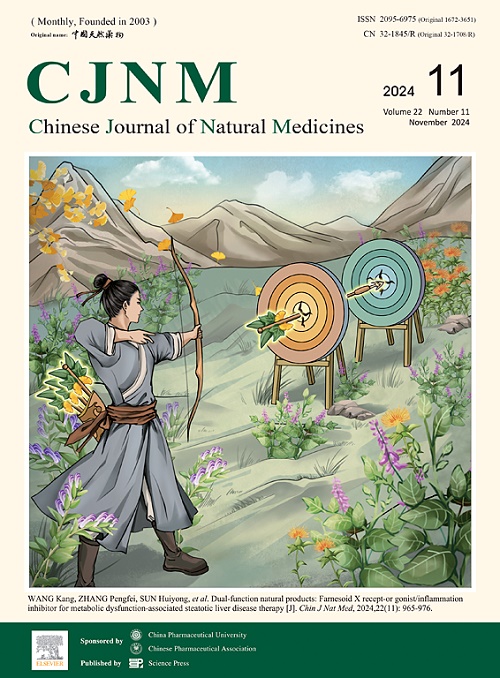Saponins from Aralia taibaiensis protect against brain ischemia/reperfusion injuries by regulating the apelin/AMPK pathway
IF 4.9
2区 医学
Q1 INTEGRATIVE & COMPLEMENTARY MEDICINE
引用次数: 0
Abstract
Aralia taibaiensi, widely distributed in western China, particularly in the Qinba Mountains, has been utilized as a folk medicine for treating diabetes, gastropathy, rheumatism, and cardiovascular diseases. Saponins from A. taibaiensis (sAT) have demonstrated protective effects against oxidative stress and mitochondrial dysfunction induced by ischemia/reperfusion (I/R). However, the underlying mechanisms remain unclear. In vivo, middle cerebral artery occlusion/reperfusion (MCAO/R) induced inflammatory infiltration, neuronal injury, cell apoptosis, mitochondrial dysfunction, and oxidative stress in the ischaemic penumbra, which were effectively mitigated by sAT. sAT increased the mRNA and protein expression levels of apelin and its receptor apelin/apelin receptors (ARs) both in vivo and in vitro. (Ala13)-Apelin-13 (F13A) and small interfering RNA (siRNA) abolished the regulatory effects of sAT on neuroprotection mediated by adenosine 5′-monophosphate (AMP)-activated protein kinase (AMPK)/protein kinase B (Akt). Furthermore, sAT induced apelin/AR expression by simultaneously inhibiting P38 mitogen-activated protein kinase (P38 MAPK)/activating transcription factor 4 (ATF4) and upregulating hypoxia-inducible factor-1α (HIF-1α). Our findings indicate that sAT regulates apelin/AR/AMPK by inhibiting P38 MAPK/ATF4 and upregulating HIF-1a, thereby suppressing oxidative stress and mitochondrial dysfunction.
太白楤木皂苷通过调节apelin/AMPK通路对脑缺血再灌注损伤具有保护作用
太白莲广泛分布在中国西部,特别是秦巴山区,是一种民间药物,用于治疗糖尿病、胃病、风湿病和心血管疾病。太白草皂苷(sAT)对缺血/再灌注(I/R)诱导的氧化应激和线粒体功能障碍具有保护作用。然而,潜在的机制仍不清楚。在体内,大脑中动脉闭塞/再灌注(MCAO/R)在缺血半暗区诱导炎症浸润、神经元损伤、细胞凋亡、线粒体功能障碍和氧化应激,sAT可有效缓解这些症状。sAT在体内和体外均可提高apelin及其受体apelin/apelin受体(ARs) mRNA和蛋白的表达水平。(Ala13)-Apelin-13 (F13A)和小干扰RNA (siRNA)消除了sAT对腺苷5 ' -单磷酸腺苷(AMP)活化蛋白激酶(AMPK)/蛋白激酶B (Akt)介导的神经保护的调节作用。此外,sAT通过同时抑制P38丝裂原活化蛋白激酶(P38 MAPK)/活化转录因子4 (ATF4)和上调缺氧诱导因子1α (HIF-1α)诱导apelin/AR表达。我们的研究结果表明,sAT通过抑制P38 MAPK/ATF4和上调HIF-1a来调节apelin/AR/AMPK,从而抑制氧化应激和线粒体功能障碍。
本文章由计算机程序翻译,如有差异,请以英文原文为准。
求助全文
约1分钟内获得全文
求助全文
来源期刊

Chinese Journal of Natural Medicines
INTEGRATIVE & COMPLEMENTARY MEDICINE-PHARMACOLOGY & PHARMACY
CiteScore
7.50
自引率
4.30%
发文量
2235
期刊介绍:
The Chinese Journal of Natural Medicines (CJNM), founded and sponsored in May 2003 by China Pharmaceutical University and the Chinese Pharmaceutical Association, is devoted to communication among pharmaceutical and medical scientists interested in the advancement of Traditional Chinese Medicines (TCM). CJNM publishes articles relating to a broad spectrum of bioactive natural products, leading compounds and medicines derived from Traditional Chinese Medicines (TCM).
Topics covered by the journal are: Resources of Traditional Chinese Medicines; Interaction and complexity of prescription; Natural Products Chemistry (including structure modification, semi-and total synthesis, bio-transformation); Pharmacology of natural products and prescription (including pharmacokinetics and toxicology); Pharmaceutics and Analytical Methods of natural products.
 求助内容:
求助内容: 应助结果提醒方式:
应助结果提醒方式:


